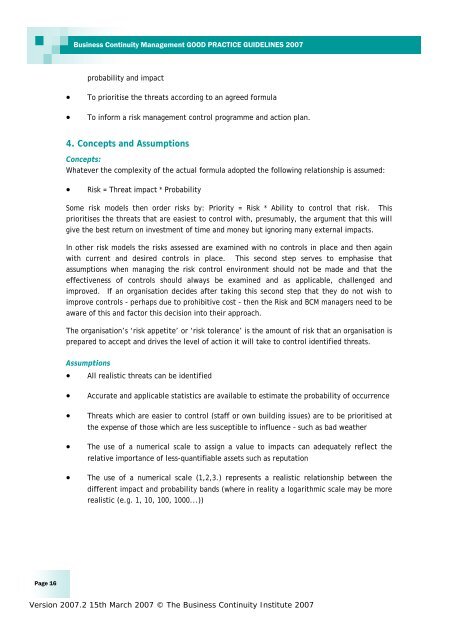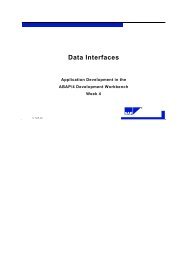business continuity institute good practice guidelines 2007
business continuity institute good practice guidelines 2007
business continuity institute good practice guidelines 2007
You also want an ePaper? Increase the reach of your titles
YUMPU automatically turns print PDFs into web optimized ePapers that Google loves.
Page 16<br />
Business Continuity Management GOOD PRACTICE GUIDELINES <strong>2007</strong><br />
probability and impact<br />
• To prioritise the threats according to an agreed formula<br />
• To inform a risk management control programme and action plan.<br />
4. Concepts and Assumptions<br />
Concepts:<br />
Whatever the complexity of the actual formula adopted the following relationship is assumed:<br />
• Risk = Threat impact * Probability<br />
Some risk models then order risks by: Priority = Risk * Ability to control that risk. This<br />
prioritises the threats that are easiest to control with, presumably, the argument that this will<br />
give the best return on investment of time and money but ignoring many external impacts.<br />
In other risk models the risks assessed are examined with no controls in place and then again<br />
with current and desired controls in place. This second step serves to emphasise that<br />
assumptions when managing the risk control environment should not be made and that the<br />
effectiveness of controls should always be examined and as applicable, challenged and<br />
improved. If an organisation decides after taking this second step that they do not wish to<br />
improve controls - perhaps due to prohibitive cost - then the Risk and BCM managers need to be<br />
aware of this and factor this decision into their approach.<br />
The organisation’s ‘risk appetite’ or ‘risk tolerance’ is the amount of risk that an organisation is<br />
prepared to accept and drives the level of action it will take to control identified threats.<br />
Assumptions<br />
• All realistic threats can be identified<br />
• Accurate and applicable statistics are available to estimate the probability of occurrence<br />
• Threats which are easier to control (staff or own building issues) are to be prioritised at<br />
the expense of those which are less susceptible to influence – such as bad weather<br />
• The use of a numerical scale to assign a value to impacts can adequately reflect the<br />
relative importance of less-quantifiable assets such as reputation<br />
• The use of a numerical scale (1,2,3.) represents a realistic relationship between the<br />
different impact and probability bands (where in reality a logarithmic scale may be more<br />
realistic (e.g. 1, 10, 100, 1000...))<br />
Version <strong>2007</strong>.2 15th March <strong>2007</strong> © The Business Continuity Institute <strong>2007</strong>
















